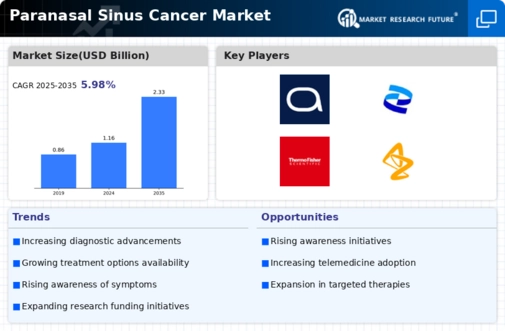Market Analysis
In-depth Analysis of Paranasal Sinus Cancer Market Industry Landscape
Pharmaceuticals may be able to help people who have been detected with a type of cancer called paranasal sinus carcinoma. Scans for sinus growth, treats them, and keeps a record of the patient's state. The market for drugs is affected by many things, such as new cures, changes in the population, and new rules. Exposure to the climate and age are two things that can change the risk of getting paranasal sinus cancer, which in turn changes the market. These days, treatments for paranasal sinus cancer are more important than ever because people are living longer and the world is becoming more dangerous. People are living longer, which is why this is the case. The market has been changed by new advances in testing tools. These changes have happened in the past few years. The ability of CT scans and MRIs to find cancers of the paranasal sinuses has changed the kinds of treatments that are available and the medicines that need to be taken. New medicines and drugs are changing the way cancer of the paranasal passages is treated. Immunotherapy, personalized treatments, and drugs made to order are all things that help people get better results with less pain and suffering. Which then causes the market to act in a different way. Extensive R&D activities affect the market. Pharmaceutical corporations pay for several things to launch new drugs. These include analyzing DNA, clinical trials, and developing novel treatments. This altered things. Regulating things that are hard to make could cause changes in the market. People who have been identified with paranasal sinus cancer now have different treatment choices because the federal government has approved new drugs and treatments. Education about paranasal sinus carcinoma changes the market. More knowledgeable patients and physicians are more inclined to seek out and utilize modern treatments. This boosts pharmacological intervention demand and market trends. The global pharmaceutical industry alters markets. Companies targeting paranasal sinus cancer markets consider regional healthcare facilities, legislation, and patient demographics. Regional healthcare affects market behavior. Well-established healthcare systems make paranasal sinus cancer treatments easier to access, affecting market trends. Health care costs, insurance coverage, and economic stability affect the market. More improved paranasal sinus cancer therapies are needed as the economy improves and individuals spend more on health care. Drug firms compete in the paranasal sinus cancer market with viable therapies. Competition fosters research, product development, and marketing, giving individuals many options to improve. Patients' advocacy and assistance initiatives alter the market. Educational, therapeutic, and management initiatives aid paranasal sinus cancer patients. They affect market trends by assisting patients.







Leave a Comment